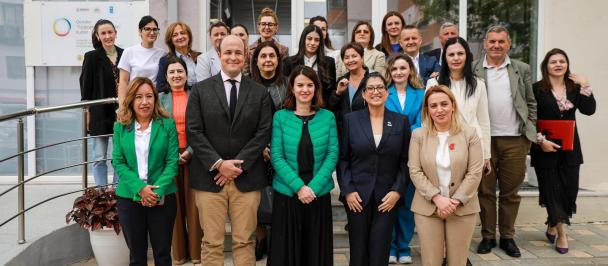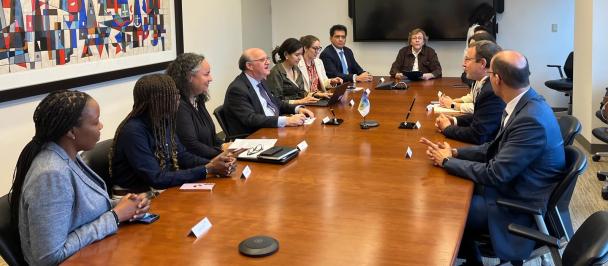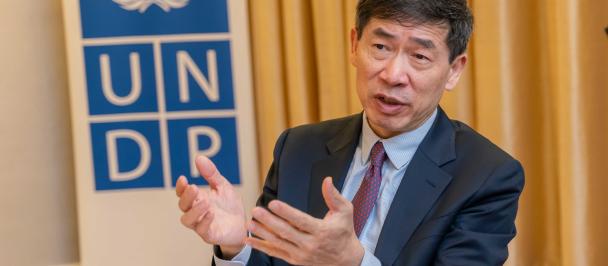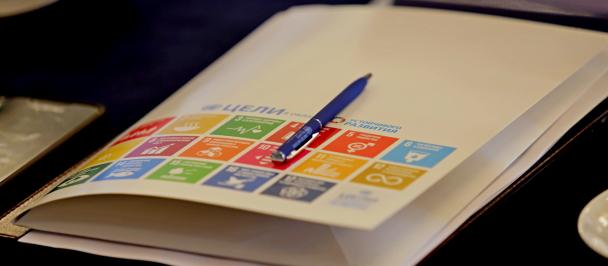United Nations Statement to the Development Committee: Joint Ministerial Committee of the Boards of Governors of the Bank and the Fund, Marrakech, October 2023
October 12, 2023
“The SDG Summit Declaration is a ringing endorsement of strong financing measures to rescue the Sustainable Development Goals.”
Antonio Guterres,
High Level Dialogue on Financing for Development,
21 September 2023
A Global Plan to Rescue the SDGs
The SDGs are off track. The international community needs to correct course, urgently, to rescue them. At the midpoint of the implementation of the 2030 Agenda, the world faces a development emergency. Only 15 percent of SDGs targets are on track and multiple Reports demonstrate that decades’ worth of development progress have been erased by the cascading crises of recent years.
Wave after wave of crises –the COVID-19 pandemic, food and energy insecurity, cost-of-living and inflation, debt distress, the climate crisis— kicked-in a slow-moving pattern of divergence between richer and poorer economies. While the past 30 years the international community largely took for granted that faster growth in developing economies would enable them to sustain their development pathways and “catch up” with the life standards of advanced economies, we are witnessing the risks of development reversals, with a rise of poverty and growing inequality across and within countries.
The macro-economic risks of climate change and transition pathways amplify these trends. It is increasingly urgent to tackle the structural imbalances in the global economy and in the international financial architecture, address the triple planetary crisis, and avoid the costs of fragmentation in the global economy and multilateral system.
Achieving shared prosperity and sustainable development will require to focus policies and actions on expanding opportunities for the poorest and most vulnerable first, including through fostering job creation and women empowerment, strengthening social protection systems, basic service delivery and universal health coverage to enhance social inclusion.
Bridge the SDGs Financing Gap
Between 2020 and 2023, 165 million additional people fell into poverty because of the cost-of-living crisis and debt distress. The SDG financing gap has become a chasm, estimated at more than $4 trillion US dollars per year. Over 40 per cent of people living in extreme poverty live in 52 countries in debt distress or at risk of debt distress.
Developing countries need to augment resilient social protection systems, provision of basic services, and universal health coverage, whose long-term benefits outweigh the immediate costs, while many of them critically lack fiscal space and means of implementation.
Rescuing the SDGs will require immediate steps to reduce the SDG financing gap: A large stimulus, an enabling environment, and an international financial system which provides equitable, affordable, and stable financing to respond to immediate crises and for long-term sustainable development.
This effort will not start from scratch. The international community can build on the wide range of unprecedented actions taken over the last years – mobilizing all sources of finance, developing innovative instruments, addressing debt vulnerabilities, increasing liquidity for countries in need, support to country-owned financing frameworks, advancing towards a more inclusive and SDGs oriented international financial system – and support the UN Secretary General’s proposal for an SDG Stimulus of at least $500 billion per year.
A Bigger and Better World Bank
The evolution towards a bigger and better World Bank is a welcome step in the right direction.
The suggested new vision and mission to end extreme poverty and boost shared prosperity on a livable planet, by fighting poverty and inequality as well as global challenges, and recognizing their interdependencies, to achieve sustainable development outcomes across the world, fit for purpose, and the eight global challenges that affect many countries and have cross-border implications are well aligned with SDG transition pathways across energy, food systems, digital, education, health, decent jobs and social protection, highlighted in the SDG Summit’s political declaration as having catalytic and multiplier effects across the SDGs.
This requires a significant increase in financing for development, which the World Bank estimates will require US$2.4 trillion per year for developing countries between 2023 and 2030, to address global challenges of climate change, conflict, and pandemics.[3]
Therefore, an evolution of the WBG financing model is also indispensable to increase its lending capacities: A substantial increase in the level of IDA by 2030 that remains the primary source of concessional financing for lower-income countries, and beyond lowering IBRD’s minimum Equity/Loan ratio from 20% to 19%, a general capital increase for IBRD, with also enhanced/contingent callable capital and hybrid capital to shareholders, including via channeling excess SDRs.
To better support country development impact in ways that increasingly respond to global challenges and connect program outcomes to global challenges, the World Bank will need to scale up its operating model, develop new concessionality principles for global challenges, considering vulnerability in IDA/IBRD eligibility.
Partnerships also will be essential and improved coordination across the multilateral system should be a particular area of focus, both for knowledge and co-financing. The United Nations and the WBG should continue to enhance knowledge generation sharing and data on global public goods and expand and deepen its strategic partnership framework for the 2030 agenda at global, regional and country levels in policy development and advocacy, joint analysis and assessments, program planning and implementation, and financial support for development.
Next Steps for the SDG Stimulus
The United Nations will continue to support MDB reform, by taking next steps on the SDG Stimulus plan presented earlier this year. An SDG Stimulus Leaders Group will be shortly established by the UN Secretary General to carry forward this initiative and deliver a set of clear steps that enable the $500 billion to start flowing before the end of 2024. We propose three specific actions to move forward:
Re-channel Special Drawing Rights, including to MDBs. We need your support to seize the opportunity originally conceived by the African Development Bank and Asian Development Bank to re-channel unused Special Drawing Rights to strengthen their balance sheets and expand lending capacity. Building on the AfDB initiative, we urge SDR holders to re-channel an additional $100 billion worth of unused SDRs overall.
Address both debt overhang and debt restructuring in developing economies: We must focus both on insolvent economies undergoing debt restructuring, and the much broader set of countries saddled with large repayment schedules that are crowding out SDG investments. For the first group, there is an urgent need to step up implementation of the Common Framework by speeding up the process and changing the eligibility criteria so that more countries can access it. For the second group, we need new solutions, recognizing that the global community has yet to offer a response to their ongoing struggles.
Mainstream state-contingent clauses: Now is the time to mainstream climate-resilient debt clauses in all official lending, to make borrowing for the future a more predictable and just endeavour. We estimate that if state-contingent debt clauses were available to the Kingdom of Morocco during the current earthquake, a 2-year pause could have freed up to $ 9.9 billion dollars in debt service payments for 2024-2025, to reconstruction work.

 Locations
Locations


